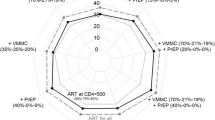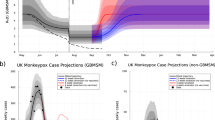Abstract
A simple mathematical model (Granich et al., Lancet 373:48–57, 2009) suggested recently that annual HIV testing of the population, with all detected HIV+ individuals immediately treated with antiretrovirals, could lead to the long-term decline of HIV in South Africa and could save millions of lives in the next few years. However, the model suggested that the long-term decline of HIV could not be achieved with less frequent HIV testing. Many observers argued that an annual testing rate was very difficult in practice. Small scale trials are nevertheless in preparation. In this paper, we use a more realistic age-structured model, which suggests that the recent high levels of reported condom use could already lead to a long-term decline of HIV in South Africa. The model therefore suggests that trials with for example 20% of the population tested each year would also be interesting. They would have similar (though smaller) advantages in terms of reduction of mortality and incidence, would be much easier to generalize to larger populations, and would not lead to long term persistence of HIV. Our model simulations also suggest that the age distribution of incidence has changed considerably over the past 20 years in South Africa. This raises some concern about an assumption presently used in EPP/Spectrum, the software used by UNAIDS for its estimates.
Similar content being viewed by others
References
Anderson, B.A., Phillips, H.E., 2006. Adult mortality (age 15–64) based on death notification data in South Africa: 1997–2004. Report No. 03-09-05, Statistics South Africa, Pretoria. www.statssa.gov.za.
Anderson, R.M., May, R.M., 1990. Infectious Diseases of Humans: Dynamics and Control. Oxford University Press, Oxford.
Bacaër, N., Ouifki, R., Pretorius, C., et al., 2008. Modeling the joint epidemics of TB and HIV in a South African township. J. Math. Biol. 57, 557–593.
Bongaarts, J., 2007. Late marriage and the HIV epidemic in sub-Saharan Africa. Popul. Stud. (Camb.) 61(1), 73–83.
Department of Health of South Africa, 2001. National HIV and Syphilis Sero-prevalence Survey of women attending Public Antenatal Clinics in South Africa 2000. www.doh.gov.za.
Department of Health, Medical Research Council, Measure DHS+, 2002. South Africa Demographic and Health Survey 1998, Department of Health, Pretoria. www.doh.gov.za/facts/1998/sadhs98/.
Department of Health of South Africa, 2003. National HIV and Syphilis Antenatal Sero-prevalence Survey in South Africa 2002. www.doh.gov.za.
Department of Health of South Africa, 2004. National HIV and Syphilis Antenatal Sero-prevalence Survey in South Africa 2003. www.doh.gov.za.
Department of Health of South Africa, 2006. National HIV and Syphilis Antenatal Sero-prevalence Survey in South Africa 2005. www.doh.gov.za.
Department of Health of South Africa, 2009. 2008 National Antenatal Sentinel HIV and Syphilis Prevalence Survey, South Africa. www.doh.gov.za.
Dorrington, R., Johnson, L., Bradshaw, D., et al., 2006. The demographic impact of HIV/AIDS in South Africa: National and Provincial Indicators for 2006, Centre for Actuarial Research, South African Medical Research Council and The Actuarial Society of South Africa. www.mrc.ac.za/bod/DemographicImpactHIVIndicators.pdf.
Dusheiko, G.M., Brink, B.A., Conradie, J.D., et al., 1989. Regional prevalence of hepatitis B, delta, and human immunodeficiency virus infection in southern Africa: a large population survey. Am. J. Epidemiol. 129, 138–145.
Ferrand, R.A., Corbett, E.L., Wood, R., et al., 2009. AIDS among older children and adolescents in Southern Africa: projecting the time course and magnitude of the epidemic. AIDS 23, 2039–2046.
Granich, R.M., Gilks, C.F., Dye, C., et al., 2009. Universal voluntary HIV testing with immediate antiretroviral therapy as a strategy for elimination of HIV transmission: a mathematical model. Lancet 373(9657), 48–57.
Hallett, T.B., Zaba, B., Todd, J., et al., 2008. Estimating incidence from prevalence in generalized epidemics: Method and validation. PLoS Med. 5(4), e80.
Hargrove, J., 2008. Migration, mines and mores: the HIV epidemic in southern Africa. South African J. Sci. 104, 53–61.
Johnson, L.F., Dorrington, R.E., 2006. Modelling the demographic impact of HIV/AIDS in South Africa and the likely impact of interventions. Demogr. Res. 14, 541–573.
Johnson, L.F., Dorrington, R.E., Bradshaw, D., et al., 2009. Sexual behaviour patterns in South Africa and their association with the spread of HIV: Insights from a mathematical model. Demogr. Res. 21, 289–339.
Shisana, O., Simbayi, L., 2002. Nelson Mandela HSRC Study of HIV/AIDS. HSRC Press, Cape Town. www.hsrcpress.ac.za.
Shisana, O., Rehle, T., Simbayi, L., et al., 2005. South African National HIV Prevalence, HIV Incidence, Behaviour and Communication Survey 2005. HSRC Press, Cape Town. www.hsrcpress.ac.za.
Shisana, O., Rehle, T., Simbayi, L., et al., 2008. South African National HIV Prevalence, Incidence, Behaviour and Communication Survey 2008. HSRC Press, Cape Town. www.hsrcpress.ac.za.
Statistics South Africa, 2009. Mortality and causes of death in South Africa, 2007: Findings from death notification. www.statssa.gov.za.
Stover, J., 2009. AIM: A computer program for making HIV/AIDS projections and examining the demographic and social impacts of AIDS, Futures Group International, Washington DC. http://software.futuresgroup.com/Spectrum/AimmanE.pdf.
UNAIDS, 2008. Report on the global AIDS epidemic. www.unaids.org.
United Nations Staistics Division, 2009. UNData. http://data.un.org.
US Census Bureau, 2009. International Database. www.census.gov/ipc/www/idb/country.php.
WHO, UNAIDS, UNICEF, 2009. Towards universal access, scaling up priority HIV/AIDS interventions in the health sector, progress report 2009. www.who.int/hiv/pub/2009progressreport/en/index.html.
Williams, B.G., Lloyd-Smith, J.O., Gouws, E., et al., 2006. The potential impact of male circumcision on HIV in Sub-Saharan Africa. PLoS Med. 3(7), 1032–1040.
Author information
Authors and Affiliations
Corresponding author
Rights and permissions
About this article
Cite this article
Bacaër, N., Pretorius, C. & Auvert, B. An Age-Structured Model for the Potential Impact of Generalized Access to Antiretrovirals on the South African HIV Epidemic. Bull. Math. Biol. 72, 2180–2198 (2010). https://doi.org/10.1007/s11538-010-9535-2
Received:
Accepted:
Published:
Issue Date:
DOI: https://doi.org/10.1007/s11538-010-9535-2




